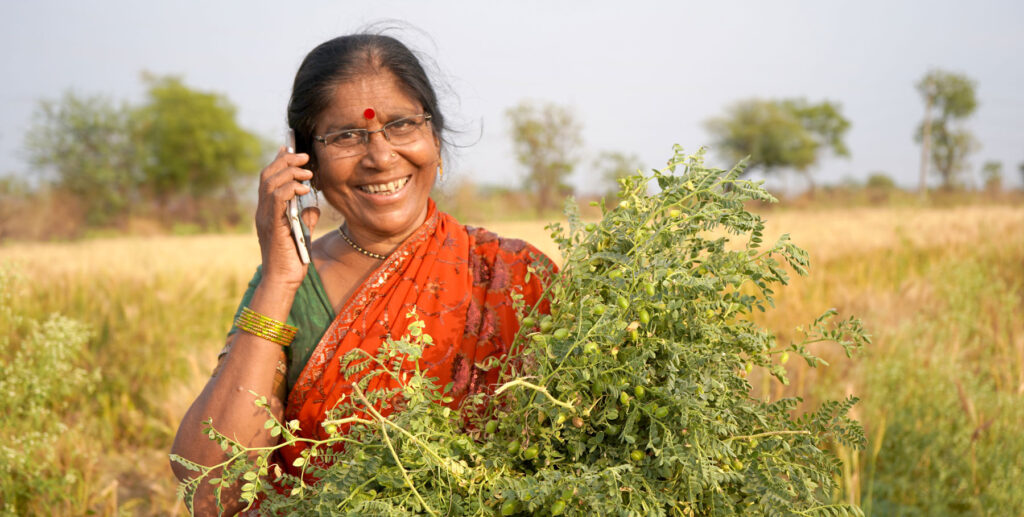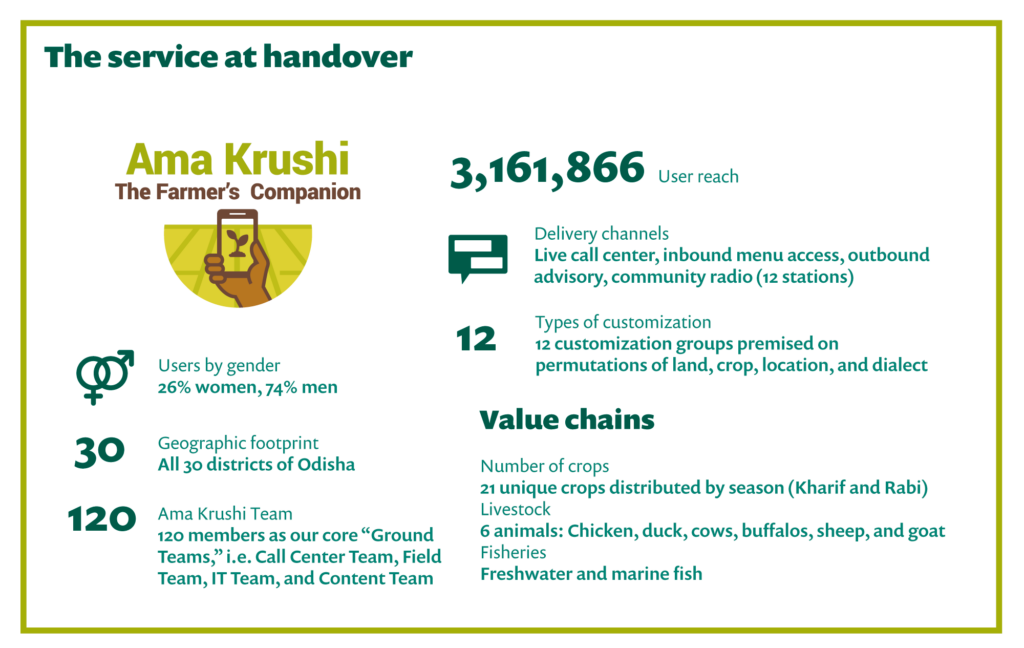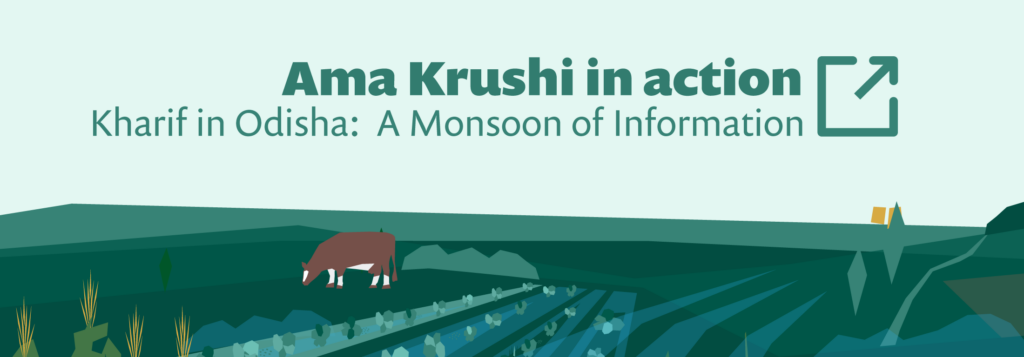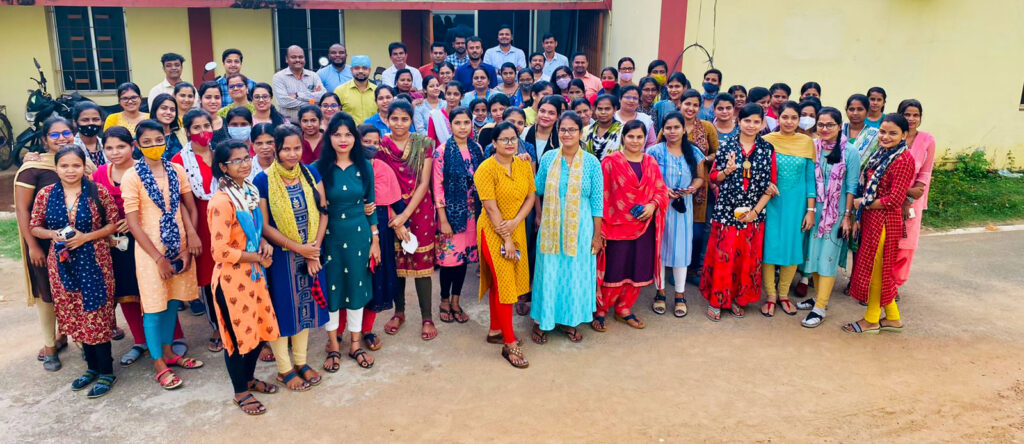Befriending the farmer: Reflections on building and transitioning the Ama Krushi service
- August 30, 2022
- 13 minutes read

On 1 August 2022, PxD completed the transition of the management and operations of Ama Krushi – our largest digital service – to Tatwa Technologies Limited, a third-party firm that won a competitive government tender. This post reflects on Ama Krushi’s journey from concept to a fully-fledged digital advisory service providing customized agronomic advice to over three million farmers, and recounts some of the hard truths, lessons learned, and innovations uncovered.
The successful handover of Ama Krushi to Tatwa is bittersweet, marking the culmination of years of work to build a sophisticated digital extension service from scratch. But the transition also means the end of a remarkable journey and a farewell not only to a service we are justly proud of, but also to longstanding colleagues who have transitioned with the service to new management.
In 2018, PxD (then Precision Agriculture for Development) – in partnership with the Department of Agriculture and Farmer Empowerment (DAFE), the Bill and Melinda Gates Foundation (BMGF), and the Abdul Latif Jameel Poverty Action Lab (J-PAL) – launched “Ama Krushi” (“farmers’ friend” in Odia, the most commonly spoken language in Odisha State). Ama Krushi was envisioned as a digital farmer-advisory platform to deliver timely, customized digital advice free of charge to smallholder farmers in the state of Odisha via their mobile phones. Conceived as a build, operate, and transfer (BOT) project, its design envisaged the transition of the management of Ama Krushi to the government of Odisha at the conclusion of the implementation and scaling period. The partners imposed an ambitious target for Ama Krushi: by March 2021, the service would have leveraged research and evidence to build and scale a cost-efficient, statewide digital extension service to serve one million farmers.
As is often the case with well-laid plans, PxD’s journey was very different from what was envisioned in 2018. The initial transition timeline to transfer day-to-day management of the service in 2021 was revised as the impacts of the COVID-19 pandemic were felt.

The formal transition ultimately commenced on 1 April 2022 with the initiation of an intensive capacity-building and transfer plan. Tatwa began operating Ama Krushi independent of PxD on 1 June, with continued technical support from PxD staff. Tatwa assumed full responsibility – with PxD becoming entirely hands off – on 1 August. At transfer, Ama Krushi was actively servicing over 3.1 million farmers.
The early days
During the first two years of project implementation, Ama Krushi grew to provide advisory and information for 16 crops across all 30 districts of the state of Odisha. After consenting to be registered, each farmer added to the service was profiled by enumerators. In profiling, a cropping profile for each farmer was created and was populated by our call center team or by our field team on the ground. An accurate profile enabled the service to direct customized content to each farmer, timed to align with critical decision points on the agricultural calendar.
In the early years, the team focused on building out Ama Krishi’s core service: an interactive voice response (IVR) push call service that delivered weekly advisory information tailored to each farmer’s profile information, and a complementary farmer hotline. By placing a missed call to the hotline, farmers received a free return call, enabling them to access a library of advisory information and frequently asked questions, and the option to leave messages to be serviced by agronomists via a recorded push call within 48 hours (typically fulfilled within 24). While any farmer could ask a question, only profiled farmers received weekly advisory.

By analyzing trends in engagement and directly interacting with users during field visits and focus groups, we gather information to inform new products and service innovations that are relevant to the needs of users. Two prominent examples include the integration of Kitchen Garden Advisory, aimed at women who engage in subsistence farming, with our regular programming, and the expansion of our advisory to include non-crop-related value chains, specifically livestock and fisheries. During the first two years of operation, the Ama Krushi team explored different avenues for expansion while deploying A/B tests to iteratively improve modes of information delivery. At the end of 2019, Ama Krushi was serving over 620,000 farmers.
Similarly, in response to demand from farmers and our partners at DAFE, PxD added new digital channels to expand our reach to smallholder farmers. Radio remains an important medium for information dissemination in rural India. Accordingly, PxD piloted advisory dissemination via a local community radio station in early 2019. By September 2020, the pilot had evolved into a formal collaboration with the Community Radio Association of Odisha, with Ama Krushi broadcasting weekly advisory across 12 community radio stations. Community radio enabled us to reach many more farmers who were not registered on the service and advise them on how to register to receive the full suite of AK digital services.

We also added a live call center (LCC) in December 2019 so that farmers could call in to be connected to a live agent. Given farmers’ limited digital literacy, we observed that many farmers had trouble navigating the inbound hotline. To make the service more accessible, DAFE requested that we build out an LCC to help reduce the technological burden on farmers. Propelled by the government of Odisha’s request to have all services offered by Ama Krushi available under one short code, the LCC was added to the main menu in February 2021 – now, should the farmer wish to, they can call 155 333 and choose whether or not to engage with a live agent to have their concerns addressed. This is supplemented by an escalation system that ensures that the farmer receives the answer on the spot or through a push call within 48 hours.
In early 2019, PxD also ramped up the training and onboarding of extension workers and other village-level champions, which allowed us to grow the number of agents that could sensitize farmers on the Ama Krushi service. It also meant that content could be disseminated via a hybrid model to these groups (e.g. IVR and district-level WhatsApp groups).
Scaling through the pandemic
At the start of 2020, in consultation with our colleagues at DAFE and BMGF, we formulated a transition plan to transfer day-to-day management of the service to a third party in 2021, as per the initial BOT agreement.
No sooner had the execution of the transition begun, however, than our plans were upended by the COVID-19 pandemic, which presented challenges that we (and most organizations across the world) did not have the experience or knowledge to contend with. We reconfigured our operations to continue offering the service while adapting our operations to work-from-home.
The move to a fully remote, work-from-home operation underscored a cornerstone advantage of digital extension services: the ability to operate at times and places that traditional extension services cannot reach. In the first month after the pandemic, we transitioned our hundred-strong call center team to work-from-home arrangements, established a system to service agriculture-related distress calls (for example, being stopped by police when taking perishable crops to market after the issuance of a statewide authorization communique) and questions from farmers during the nationwide lockdown, and assisted the government of Odisha to deliver key agriculture-related updates to remote areas. The Ama Krushi team demonstrated remarkable resilience, maintaining and then building their capacity to serve farmers. The Ama Krushi service was available every day of the nationwide lockdown and subsequent phases of physical-distancing protocols, .
Despite significant operational adjustments imposed by the pandemic, Ama Krushi surpassed its target of servicing one million farmers in November 2020, five months ahead of DAFE’s initial target. Bolstered by Ama Krushi’s success, the government of Odisha issued a directive defining new targets and goals in March 2021. With additional support from BMGF, we received approval to launch advisory channels to support livestock and fisheries on the Ama Krushi platform. The government of Odisha also revised the end goal of onboarding 1 million farmers by March 2021 to 2.5 million farmers by June 2021.
While these requests reflected the Odisha government’s faith in Ama Krushi and our team, the revised targets and deadlines presented challenges for the handover of the service. COVID-19-related concessions had allowed for the extension of the original transition timeline from March 2021 to September 2021, but the addition of livestock and fisheries went beyond the scope of the original agreement and required us to test, launch, stabilize, and hand over a new version of the service within six months.
Undeterred, the Ama Krushi team quickly commenced piloting and testing to support the development of livestock and fisheries advisory, launching the two new advisory channels in January and April 2021, respectively. Concurrently, we continued to leverage research and user feedback to improve the service and began preparing operations and management materials in preparation for the handover.

Collating and organizing information about the service and the platform operations was an extensive exercise that required the creation of a large vault of documents. These documents detailed how the service worked (even as the service continued to change), outlined a framework to facilitate capacity building to support the transition of workstream ownership from PxDs’ team to government officers, and created a learning agenda to document and monitor the transition and inform future efforts.
Transition
Coordinating with the government during the pandemic was challenging – understandably, as their focus had shifted to the resolution of pressing issues. Coupled with the adjustment to work-from-home arrangements and personnel changes in critical official roles, discussions, and decisions to guide the Ama Krushi transition slowed.
At a meeting in March 2021, the government committee, chaired by the then Principal Secretary, met to decide what form the Ama Krushi transition would take. Early considerations had included embedding government staff within the Ama Krushi team, but given the complexity of operations, the government indicated a strong preference for a procurement process to contract out management of the service to a third party, while retaining government oversight and ownership. Naturally, this development led to a series of internal considerations. What form would the transition now take? How would the third party engage with the government and the program? What would happen to program staff who had been trained with a view of being transitioned to government management? How would the service remain government-owned and -funded in the long term?
After exploring the route of procurement via impaneled agencies with the Government of Odisha, PxD and DAFE came to the conclusion that, given the size and complexity of Ama Krushi and its teams, the identification of a new implementing partner would require a full public procurement process facilitated by a request for proposals (RFP). 1An RFP is essentially an open tender:an advertisement for a service that the government requires (in this case, the management of the Ama Krushi program) is put out for a minimum period of time with a set of eligibility criteria. It invites bidders to submit a tentative budget and uses a careful scoring system to identify the best-qualified party for the task. In July 2021, the government published an RFP inviting candidates to take up the tender. The plan of transitioning the service in 2021 seemed unlikely.
The PxD team running Ama Krushi was funded by both BMGF and DAFE and comprised “ground teams” running everyday operations like profiling, content delivery, fieldwork, and IT maintenance, in addition to a dynamic data and management team. The RFP proposed a different model: the entire program would now be funded by DAFE, with the management team comprised of a Program Lead – to be filled by a government official – in charge of a program management team staffed by the organization identified through the tender, who in turn would manage the work of the ground/operational teams. We had expected that the ground teams would remain in place given that they are critical for program continuity, but there was no guarantee that the new entity would absorb the existing operational team. Suddenly, the future of our 120-people strong operational team looked uncertain.
Handover to Tatwa
Given the repeated delays and shifting parameters of the transition, we agreed with DAFE and BMGF to further extend the transition timeline to 31 March 2022.
At the conclusion of the RFP process, the government appointed Tatwa Technologies Limited as the third-party firm to take over Ama Krushi’s management and operations. Following the announcement, PxD facilitated an extensive capacity-building program premised on in-person workshops and intensive shadowing. Tatwa wisely chose to retain the program’s existing ground teams, ensuring that Ama Krushi’s operations would run smoothly, with little to no inconvenience to Ama Krushi’s now 3.1 million farmers. On 31 May 2022, PxD successfully transferred the day-to-day management of the Ama Krushi program to Tatwa Technologies. After an additional two months of technical support, PxD is no longer involved in the delivery and development of Ama Krushi’s services.
Needless to say, building and then handing over the program has been an immense learning experience. Odisha farmers relied on traditional knowledge for generations to navigate challenges associated with drought, cyclones, and other input-based complexities. Ama Krushi attempted to complement this traditional knowledge with an agricultural digital extension service capable of delivering credible, scientifically validated, and evidence-based digital information to improve decision-making, agricultural productivity, and smallholder livelihoods. We scaled a program from 50,000 farmers in 2018 to over three million in 2022, from one crop to 29 value chains spanning crops, livestock, and fisheries – all with the support of a growing team of content experts, field coordinators, and surveyors. Today, we can proudly say that Ama Krushi is an entirely government-funded and government-owned service running at scale. The transition formally concluded on 31 July 2022.
A fond farewell
Building a successful digital extension service like Ama Krushi and overseeing its successful handover was the product of years of hard work and effort. The learning curve has been steep, with unexpected accelerations in the ascent, as well as detours and changed plans. No success would have been possible without the active and sustained support of the BMGF and all of the government officials from DAFE. As a team, we learned to consistently check our assumptions and biases, systematically plan for contingencies, tailor our communications, manage expectations, and make ourselves more attuned to context-specific nuances. We will catalog these learnings as part of the post-transition monitoring exercise to inform future transition efforts (both internal and external) and provide insights for different use cases. We hope to leverage active learning from this transition to identify best practices for laying a foundation for a successful transition during the build and operate phases of development, and for successfully executing transition as the fulfillment of the build, operate, and transfer design.

Stay Updated with Our Newsletter

Make an Impact Today



